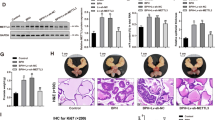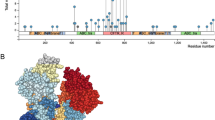Abstract
Background
Dysregulated apoptosis of penile mesenchymal cells during male urethragenesis has been previously demonstrated to underly hypospadiac urethral closure failure, and androgen receptor (AR) has been shown to play a central role in regulating penile mesenchyme cell proliferation and survival. However, the regulatory mechanisms upstream and downstream of AR remain poorly understood. Our clinical data and bioinformatics analysis previously indicated that hsa_circ_0000417, a circRNA significantly downregulated in hypospadias preputial specimens, may act as a ceRNA for AR via sequestering hsa_miR-6756-5p, and that the biological functions of hsa_circ_0000417 may significantly involve the PI3K/AKT pathway. In this study, we employed human foreskin fibroblasts (HFF-1) to experimentally validate this putative hsa_circ_0000417/miR-6756-5p/AR axis and its impact on penile mesenchymal cell proliferation and apoptosis.
Method and results
We showed that hsa_circ_0000417 knockdown significantly promoted proliferation and suppressed apoptosis of HFF-1 cells. Mechanistically, hsa_circ_0000417 functioned as a molecular sponge for miR-6756-5p in HFF-1 cells and relieved the latter’s translational repression on AR mRNA, leading to decreased AKT activation and increased expression of pro-apoptotic proteins BAX and cleaved-caspase 9. Conversely, elevated levels of miR-6756-5p resulted in diminished AR expression concomitant with enhanced AKT activation and HFF-1 cell proliferation.
Conclusions
Collectively, our data describe for the first time a circRNA-mediated post-transcriptional regulatory mechanism of AR and its functional consequences in penile mesenchymal cells in the context of hypospadias. These findings may contribute to advancing our current understanding of the roles of AR and mesenchymal cell fate decisions during penile morphogenesis.




Similar content being viewed by others
Data availability
No Data associated in the manuscript.
References
Blaschko SD, Cunha GR, Baskin LS (2012) Molecular mechanisms of external genitalia development. Differentiation 84(3):261–268. https://doi.org/10.1016/j.diff.2012.06.003
Bouty A, Ayers KL, Pask A, Heloury Y, Sinclair AH (2015) The genetic and environmental factors underlying hypospadias. Sex Dev 9(5):239–259. https://doi.org/10.1159/000441988
Seifert AW, Harfe BD, Cohn MJ (2008) Cell lineage analysis demonstrates an endodermal origin of the distal urethra and perineum. Dev Biol 318(1):143–152. https://doi.org/10.1016/j.ydbio.2008.03.017
Sinclair AW, Cao M, Pask A, Baskin L, Cunha GR (2017) Flutamide-induced hypospadias in rats: a critical assessment. Differentiation 94:37–57. https://doi.org/10.1016/j.diff.2016.12.001
Liu X, Liu G, Shen J, Yue A, Isaacson D, Sinclair A, Cao M, Liaw A, Cunha GR, Baskin L (2018) Human glans and preputial development. Differentiation 103:86–99. https://doi.org/10.1016/j.diff.2018.08.002
Cunha GR, Sinclair A, Cao M, Baskin LS (2020) Development of the human prepuce and its innervation. Differentiation 111:22–40. https://doi.org/10.1016/j.diff.2019.10.002
Baskin LS, Erol A, Jegatheesan P, Li Y, Liu W, Cunha GR (2001) Urethral seam formation and hypospadias. Cell Tissue Res 305(3):379–387. https://doi.org/10.1007/s004410000345
Suzuki H, Matsushita S, Suzuki K, Yamada G (2017) 5α-dihydrotestosterone negatively regulates cell proliferation of the periurethral ventral mesenchyme during urethral tube formation in the murine male genital tubercle. Andrology 5(1):146–152. https://doi.org/10.1111/andr.12241
Miyagawa S, Satoh Y, Haraguchi R, Suzuki K, Iguchi T, Taketo MM, Nakagata N, Matsumoto T, Takeyama K, Kato S, Yamada G (2009) Genetic interactions of the androgen and Wnt/beta-catenin pathways for the masculinization of external genitalia. Mol Endocrinol 23(6):871–880. https://doi.org/10.1210/me.2008-0478
Zheng Z, Armfield BA, Cohn MJ (2015) Timing of androgen receptor disruption and estrogen exposure underlies a spectrum of congenital penile anomalies. Proc Natl Acad Sci 112(52):E7194-7203. https://doi.org/10.1073/pnas.1515981112
Hyuga T, Suzuki K, Acebedo AR, Hashimoto D, Kajimoto M, Miyagawa S, Enmi JI, Yoshioka Y, Yamada G (2019) Regulatory roles of epithelial-mesenchymal interaction (EMI) during early and androgen dependent external genitalia development. Differentiation 110:29–35. https://doi.org/10.1016/j.diff.2019.08.004
Matsushita S, Suzuki K, Murashima A, Kajioka D, Acebedo AR, Miyagawa S, Haraguchi R, Ogino Y, Yamada G (2018) Regulation of masculinization: androgen signalling for external genitalia development. Nat Rev Urol 15(6):358–368. https://doi.org/10.1038/s41585-018-0008-y
Bononi A, Agnoletto C, De Marchi E, Marchi S, Patergnani S, Bonora M, Giorgi C, Missiroli S, Poletti F, Rimessi A, Pinton P (2011) Protein kinases and phosphatases in the control of cell fate. Enzyme Res 2011:329098. https://doi.org/10.4061/2011/329098
Zhu W, Nelson CM (2012) PI3K signaling in the regulation of branching morphogenesis. Bio Syst 109(3):403–411. https://doi.org/10.1016/j.biosystems.2012.04.004
Yu JS, Cui W (2016) Proliferation, survival and metabolism: the role of PI3K/AKT/mTOR signalling in pluripotency and cell fate determination. Development 143(17):3050–3060. https://doi.org/10.1242/dev.137075
Ghosh S, Lau H, Simons BW, Powell JD, Meyers DJ, De Marzo AM, Berman DM, Lotan TL (2011) PI3K/mTOR signaling regulates prostatic branching morphogenesis. Dev Biol 360(2):329–342. https://doi.org/10.1016/j.ydbio.2011.09.027
Fujino A, Arango NA, Zhan Y, Manganaro TF, Li X, MacLaughlin DT, Donahoe PK (2009) Cell migration and activated PI3K/AKT-directed elongation in the developing rat mullerian duct. Dev Biol 325(2):351–362. https://doi.org/10.1016/j.ydbio.2008.10.027
Carver BS, Chapinski C, Wongvipat J, Hieronymus H, Chen Y, Chandarlapaty S, Arora VK, Le C, Koutcher J, Scher H, Scardino PT, Rosen N, Sawyers CL (2011) Reciprocal feedback regulation of PI3K and androgen receptor signaling in PTEN-deficient prostate cancer. Cancer Cell 19(5):575–586. https://doi.org/10.1016/j.ccr.2011.04.008
Thomas C, Lamoureux F, Crafter C, Davies BR, Beraldi E, Fazli L, Kim S, Thaper D, Gleave ME, Zoubeidi A (2013) Synergistic targeting of PI3K/AKT pathway and androgen receptor axis significantly delays castration-resistant prostate cancer progression in vivo. Mol Cancer Ther 12(11):2342–2355. https://doi.org/10.1158/1535-7163.MCT-13-0032
Marques RB, Aghai A, de Ridder CMA, Stuurman D, Hoeben S, Boer A, Ellston RP, Barry ST, Davies BR, Trapman J, van Weerden WM (2015) High efficacy of combination therapy using PI3K/AKT inhibitors with androgen deprivation in prostate cancer preclinical models. Eur Urol 67(6):1177–1185. https://doi.org/10.1016/j.eururo.2014.08.053
Kahn B, Collazo J, Kyprianou N (2014) Androgen receptor as a driver of therapeutic resistance in advanced prostate cancer. Int J Biol Sci 10(6):588–595. https://doi.org/10.7150/ijbs.8671
Lin Z, Tang X, Wan J, Zhang X, Liu C, Liu T (2021) Functions and mechanisms of circular RNAs in regulating stem cell differentiation. RNA Biol 18(12):2136–2149. https://doi.org/10.1080/15476286.2021.1913551
Di Timoteo G, Rossi F, Bozzoni I (2020) Circular RNAs in cell differentiation and development. Development. https://doi.org/10.1242/dev.182725
Kristensen LS, Jakobsen T, Hager H, Kjems J (2022) The emerging roles of circRNAs in cancer and oncology. Nat Rev Clin Oncol 19(3):188–206. https://doi.org/10.1038/s41571-021-00585-y
Chen LL, Yang L (2015) Regulation of circRNA biogenesis. RNA Biol 12(4):381–388. https://doi.org/10.1080/15476286.2015.1020271
Ho JJD, Man JHS, Schatz JH, Marsden PA (2021) Translational remodeling by RNA-binding proteins and noncoding RNAs. Wiley Interdiscip Rev RNA 12(5):e1647. https://doi.org/10.1002/wrna.1647
Li X, Yang L, Chen LL (2018) The biogenesis, functions, and challenges of circular RNAs. Mol Cell 71(3):428–442. https://doi.org/10.1016/j.molcel.2018.06.034
Chao C, Jian YY, Zhao XY, Liu YL, Xie QK (2020) The involvement of hsa_circ_0000417 in the development of hypospadias by regulating AR. Differ Res Biol Divers 116:9–15. https://doi.org/10.1016/j.diff.2020.09.003
Vottero A, Minari R, Viani I, Tassi F, Bonatti F, Neri TM, Bertolini L, Bernasconi S, Ghizzoni L (2011) Evidence for epigenetic abnormalities of the androgen receptor gene in foreskin from children with hypospadias. J Clin Endocrinol Metab 96(12):E1953–1962. https://doi.org/10.1210/jc.2011-0511
Svensson J, Snochowski M (1979) Androgen receptor levels in preputial skin from boys with hypospadias. J Clin Endocrinol Metab 49(3):340–345. https://doi.org/10.1210/jcem-49-3-340
An Y, Liu X, Tang Y, Liu J, Li J, Luo Y, Qiu M (2012) Expression of androgen receptor in genital tissue of patients with congenital hypospadias and simple chordee. Zhongguo Xiu Fu Chong Jian Wai Ke Za Zhi 26(4):461–465
Silva TS, Richeti F, Cunha DP, Amarante AC, de Souza Leao JQ, Longui CA (2013) Androgen receptor mRNA measured by quantitative real time PCR is decreased in the urethral mucosa of patients with middle idiopathic hypospadias. Horm Metabol Res 45(7):495–500. https://doi.org/10.1055/s-0033-1333717
Chen Z, Lin X, Wang Y, Xie H, Chen F (2020) Dysregulated expression of androgen metabolism genes and genetic analysis in hypospadias. Mol Genet Genom Med 8(8):e1346. https://doi.org/10.1002/mgg3.1346
Tai C, Xie Z, Li Y, Feng Y, Xie Y, Yang H, Wang L, Wang B (2022) Human skin dermis-derived fibroblasts are a kind of functional mesenchymal stromal cells: judgements from surface markers, biological characteristics, to therapeutic efficacy. Cell Biosci 12(1):105. https://doi.org/10.1186/s13578-022-00842-2
Morgan EA, Nguyen SB, Scott V, Stadler HS (2003) Loss of Bmp7 and Fgf8 signaling in Hoxa13-mutant mice causes hypospadia. Development 130(14):3095–3109. https://doi.org/10.1242/dev.00530
Valencia-Sanchez MA, Liu J, Hannon GJ, Parker R (2006) Control of translation and mRNA degradation by miRNAs and siRNAs. Genes Dev 20(5):515–524. https://doi.org/10.1101/gad.1399806
Karabulut R, Turkyilmaz Z, Sonmez K, Kumas G, Ergun S, Ergun M, Basaklar A (2013) Twenty-four genes are upregulated in patients with Hypospadias. Balkan J Med Genet 16(2):39–44. https://doi.org/10.2478/bjmg-2013-0030
Pineyro-Ruiz C, Serrano H, Jorge I, Miranda-Valentin E, Perez-Brayfield MR, Camafeita E, Mesa R, Vazquez J, Jorge JC (2020) A Proteomics signature of mild hypospadias: a pilot study. Front Pediatr 8:586287. https://doi.org/10.3389/fped.2020.586287
van Rossum D, Verheijen BM, Pasterkamp RJ (2016) Circular RNAs: Novel regulators of neuronal development. Front Mol Neurosci 9:74. https://doi.org/10.3389/fnmol.2016.00074
Mahmoudi E, Cairns MJ (2019) Circular RNAs are temporospatially regulated throughout development and ageing in the rat. Sci Rep 9(1):2564. https://doi.org/10.1038/s41598-019-38860-9
Hong L, Gu T, He Y, Zhou C, Hu Q, Wang X, Zheng E, Huang S, Xu Z, Yang J, Yang H, Li Z, Liu D, Cai G, Wu Z (2019) Genome-wide analysis of circular RNAs mediated ceRNA regulation in porcine embryonic muscle development. Front Cell Dev Biol 7:289. https://doi.org/10.3389/fcell.2019.00289
Baskin L, Shen J, Sinclair A, Cao M, Liu X, Liu G, Isaacson D, Overland M, Li Y, Cunha GR (2018) Development of the human penis and clitoris. Differentiation 103:74–85. https://doi.org/10.1016/j.diff.2018.08.001
Baskin L, Cao M, Sinclair A, Li Y, Overland M, Isaacson D, Cunha GR (2020) Androgen and estrogen receptor expression in the developing human penis and clitoris. Differentiation 111:41–59. https://doi.org/10.1016/j.diff.2019.08.005
Salzman J (2016) Circular RNA expression: its potential regulation and function. Trends Genet 32(5):309–316. https://doi.org/10.1016/j.tig.2016.03.002
Patop IL, Wust S, Kadener S (2019) Past, present, and future of circRNAs. EMBO J 38(16):e100836. https://doi.org/10.15252/embj.2018100836
Hanan M, Soreq H, Kadener S (2017) CircRNAs in the brain. RNA Biol 14(8):1028–1034. https://doi.org/10.1080/15476286.2016.1255398
Kong X, Luo J, Xiang H, Wang S, Shen L, Long C, Liu F, Lin T, He D, Liu X, Wei GH (2021) Expression of Mafb is down-regulated in the foreskin of children with hypospadias. J Pediatr Urol 17(1):70e71–70e76. https://doi.org/10.1016/j.jpurol.2020.10.006
Kong X, Liu Z, Long C, Shen L, Liu X, Wei G (2022) Repression of Mafb promotes foreskin fibroblast proliferation through upregulation of CDK2, cyclin E and PCNA. Andrologia 54(6):e14411. https://doi.org/10.1111/and.14411
Funding
This work was supported by the National Natural Science Foundation of China (82060129), the “Medical Excellence Award” funded by the Creative Research Development Grant from the First Affiliated Hospital of Guangxi Medical University (2017026), 2018 Guangxi Scholarship Fund of Guangxi Education Department and Key Research and Development Program of Guangxi Province (GuiKe.AB18221028).
Author information
Authors and Affiliations
Contributions
Conceptualization, data curation, investigation, data analysis, visualization: JH, CS, XZ, CC, PL. Software, statistical analysis: YL, QX. Manuscript writing and editing: PL, JH. Supervision: CC.
Corresponding author
Ethics declarations
Conflict of interest
All authors declare no conflict of interest.
Ethical approval
This article does not contain any studies with human participants or animals performed by any of the authors.
Additional information
Publisher’s Note
Springer Nature remains neutral with regard to jurisdictional claims in published maps and institutional affiliations.
Rights and permissions
Springer Nature or its licensor (e.g. a society or other partner) holds exclusive rights to this article under a publishing agreement with the author(s) or other rightsholder(s); author self-archiving of the accepted manuscript version of this article is solely governed by the terms of such publishing agreement and applicable law.
About this article
Cite this article
Huang, J., Su, C., Lu, P. et al. hsa_circ_0000417 downregulation suppresses androgen receptor expression and apoptotic signals in human foreskin fibroblasts via sponging miR-6756-5p. Mol Biol Rep 50, 6769–6781 (2023). https://doi.org/10.1007/s11033-023-08628-6
Received:
Accepted:
Published:
Issue Date:
DOI: https://doi.org/10.1007/s11033-023-08628-6




